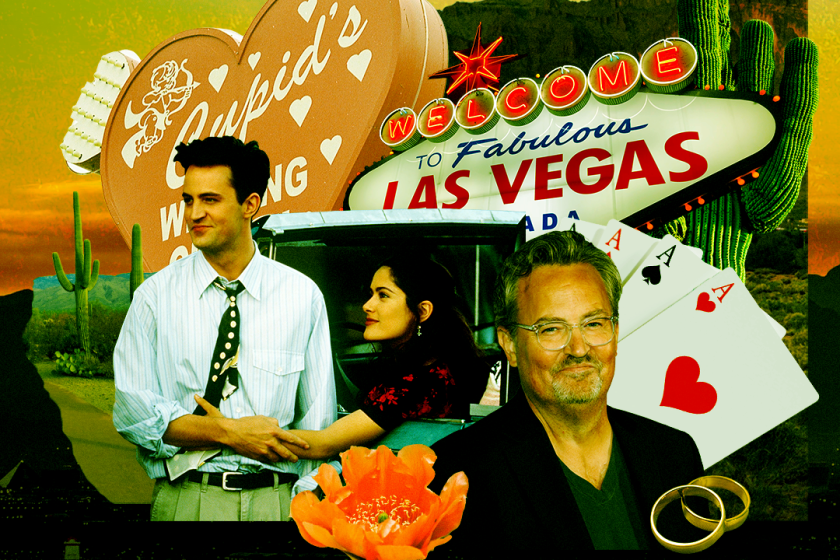
- Share via
It’s a little funny that “representation” itself is suffering from an optics problem.
Among my politically minded friends, the word elicits eyerolls for how it’s come to characterize the concerns of a subset of out-of-touch activist influencers. Alienated from the more urgent, material concerns of their communities, they opt instead to endlessly bleat about how important it is that an alien slug creature in “Star Wars” is bisexual, or that we get a Disney princess who knows what vivaporú is.
But new research is showing just how dire the state of Latino representation in Hollywood really is, and it’s making at least one cynical Chicano (me) reconsider the subject. Not because I’m dying to “see myself onscreen” (perhaps the space slug is Mexican American), but because I’m interested in how Hollywood functions as the main storytelling apparatus in the United States.
Looking into how such a powerful entity approaches Latinidad, what it shows and doesn’t show, who it elevates and who it overlooks, has a lot to tell us about how people in our country see each other, themselves and the world beyond our borders.
First, the data. According to the recent report from the Annenberg Inclusion Initiative at the University of Southern California, Latino representation in Hollywood has not shown any meaningful growth in the last 16 years.
Latinos have been historically underrepresented onscreen, and while the mission of getting more Latinos in movies continues, we wanted to highlight films we connect to. From Latino classics to ‘Latino-coded,’ here are the staff picks.
Despite Latinos accounting for around 19% of the U.S. population, only 4.4% of actors in lead or co-lead roles were Latino, and fewer than 1% were Afro Latino. Of the Latino characters that did make it to the screen, they often were depicted as immigrants (24%), low-income (also 24%), violent criminals (46.2%) and angry or temperamental (40%).
Every culture, country or ethnic group is a fragile project held together by duct tape and shared myths. In the most literal sense, we are the stories we tell. That’s how we communicate our values, goals and beliefs, bonding agents for individuals who might otherwise not have much in common.
In the U.S., Hollywood is the greatest proliferator of American myths, drawing on the sentiments and anxieties of our time and reflecting them back to us in a visual, legible way in order to affirm, “This is who we are.”
Looking at our place in that rich narrative tapestry, it becomes clear how the average American in the U.S. thinks about Latinos: Latinos are immigrants, often violent, or at least come from violent backgrounds. Latinos do low-paying jobs. And, above all, Latinos are invisible.
The Matthew Perry-Salma Hayek rom-com withstood the test of time and is still a great lesson in intercultural relationships.
When a group of people makes up such a sizable chunk of a society but is not shown to exist in that society’s mainstream art, that’s not negligence. It’s intentional exclusion.
This dovetails quite neatly with stereotypes about Latinos beyond Hollywood, which is to be expected.
Hollywood draws its stories from prevailing cultural attitudes and beliefs. One of those beliefs is the expectation that Latinos go about their lives quietly and in discreet service, making the bed, picking the fruit and cooking the food. Even in the more, let’s say “criminal” roles, these involve activities that happen in the shadows, in the hidden underbelly of civilized society or concealed from public view in prisons.
I certainly don’t mean to say that the stories of low-income Latinos, Latinos in risky, undercompensated jobs, undocumented Latinos aren’t important, or even that criminal Latinos are unimportant. “Orange Is the New Black” brought some vivid Latina characters to the forefront, for example. But this is all to say that the nonrepresentation of Latinos in U.S. film is itself a representation, a statement on where Latinos fit into the national project.
Despite a marketing hurdle, the Mexican film ‘Radical’ reached No. 5 at the U.S. box office, grossing $2.7 million in its first week.
To be fair, though, there are other contributing factors. One is the continued idea that “Latino” is a cohesive identity marker that can be marketed to as one group. There’s a world of difference between, say, a Chicano lead character and a Cuban American one. There are some similarities and shared experiences, but it’s a lot to ask of one media product to speak to every Latino.
Many Latinos in diaspora also live in relatively close proximity to the countries of their parents and grandparents, meaning they might simply turn to media from those nations. Mexico, for example, is a cinema juggernaut.
It’s not all doom and gloom here in the U.S., either. “Radical,” a Mexican film about teacher Sergio Juarez and his students in the Mexican border town of Matamoros, recently was released in the U.S. and hit No. 5 at the box office in its opening weekend, grossing $2.7 million; it’s expected to continue growing with word-of-mouth.
Commentary: ‘Stand and Deliver’ avoids tropes and proves it’s still relevant decades after release
‘Stand and Deliver’ avoids common tropes and proves to be still relevant decades after its cinematic release
Still, there’s no excuse for Hollywood’s lack of Latino representation. Latinos have kept the movie industry afloat, accounting for 29% of movie tickets sold in 2020, a year when the industry was brought to its knees by the pandemic.
This is despite a lack of films featuring Latinos, which I think speaks to another overlooked fact: Latinos don’t need to be pandered to. We show up for good stories, and we want to be in them. It’s not that complicated.
Every once in a while Hollywood will put out a “we’re sorry” project that takes Latino representation to the extreme. It is marketed as “the big Latino movie,” and then, when it doesn’t meet its lofty goal of exciting 19% of the population enough to be a massive hit, it feeds the narrative that Latinos are difficult to market to and Latino projects don’t make money.
Stories are what define any given culture. That’s always been the case throughout human history. It’s maddening, frightening and frankly macabre to constitute so much of a nation’s population and be given so little space in one of its most prominent narrative traditions. It says a lot about how Latinos are seen, and, of course, how they’re not.
JP Brammer is a columnist, author, illustrator and content creator based in Brooklyn. He is the author of ”Hola Papi: How to Come Out in a Walmart Parking Lot and Other Life Lessons,” based on his successful advice column. He has written for outlets including the Guardian, NBC News and the Washington Post. He writes a weekly column for De Los.
More to Read
The Latinx experience chronicled
Get the Latinx Files newsletter for stories that capture the multitudes within our communities.
You may occasionally receive promotional content from the Los Angeles Times.










